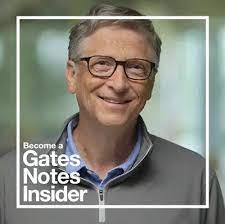Michael R. MacDonald, PhD
Birds do it. Bees do it. Even billionaires do it.
This is a take-off on a famous song by Cole Porter, called Let’s do it (Let’s fall in love). I bet you even have that tune humming in your head right now.
You can start doing it too by allocating as little as 1% of your estate in your will. You may even fall in love with the idea – and feel like a billionaire.
BILL AND MELINDA DO IT
Here’s an excerpt from a recent Gates Foundation newsletter.

This year the Bill & Melinda Gates Foundation has committed to spending $8.6 billion to help meet mounting needs and fund innovative ways to save and improve lives.
By focusing on the areas of greatest human need, we can realize the full potential of philanthropy at the moment when the world needs it most.
CHUCK FEENEY DID IT
Here is another amazing example from their newsletter.
Last year, a man named Chuck Feeney died, at the age of 92. Feeney was a billionaire, but you might not have heard of him.
He purposely led a low-profile life—he wore a ten-dollar watch and, in his final years, didn’t own a house or a car. The field where he made his billions, duty-free shopping, doesn’t grab many headlines.
You won’t find Feeney’s name carved on buildings—but his legacy is indelible.
In 2011, Feeney joined the Giving Pledge, a movement of individuals with extraordinary wealth who commit to giving the majority of it to charitable causes during their lifetimes or in their wills. At the time, he wrote, “I cannot think of a more personally rewarding and appropriate use of wealth than to give while one is living, to personally devote oneself to meaningful efforts to improve the human condition.”
Feeney’s humble but powerful philanthropy inspired so many people, including Warren Buffett and our foundation’s co-chairs, Bill Gates and Melinda French Gates. He showed us all how the actions of one generous person can set the wheels in motion for generations of progress.
HOW CHUCK FEENEY DID IT
Mark Suzman, CEO of the Bill and Melinda Gates Foundation explains.
“What made Feeney remarkable isn’t what he said he’d do—it’s how thoroughly and thoughtfully he did it. He gave away virtually all his wealth while he was alive. And he gave it to a vast array of causes around the world: public health system strengthening in Vietnam, HIV clinics in South Africa, and grassroots campaigns to expand health care coverage to people with low incomes, to name a few.”
DOING IT EFFECTIVELY
Although he doesn’t mention it by name, this approach follows some of the basic tenets of Effective Altruism, which I have written about in a previous post, titled The Heart and Head of Giving – from Peter Singer.
Here are some details from this post.
According to Singer, altruism can help way more than we might realize and Effective Altruism can help even more.
Effective Altruism advocates using our hearts and our minds. It is a growing social movement, which promotes the use of reason and evidence as guide for giving (and volunteering). This approach ensures that every dollar we donate helps as much as possible.
According to the Effective Altruism website, working on a cause is likely to be highly impactful to the extent that the cause is:
- Great in scale (it affects many lives, by a great amount)
- Highly neglected (few other people are working on addressing the problem), and
- Highly solvable or tractable (additional resources will do a great deal to address it).
Some advocates are hardcore and focus on saving lives. And they measure the worth of their donations in terms of cost per life saved. To me, this is only one important measure of effectiveness.
There are other vitally important goals as well, such as improving the lives of the living, reducing suffering, and helping create a more equitable world through education and gender equality.
Singer has argued that some charities are more than a thousand times as effective as others. And who could argue that evidence isn’t a useful cornerstone. See the homepage of A Warm Heart for more striking (I think) evidence.
Bill and Melinda Gates (self-described “impatient optimists” along with Warren Buffett) have used this evidence-based approach to become the most successful philanthropists in history.
I think an important take away from Singer’s talk is that our heads and our hearts are both vitally important. We will be more likely to give if we feel reassured that our hard-earned money is really going to make a difference. And we can keep giving if we know that the money is used to help effectively.
YOU CAN START WITH ONE PERCENT
There are many simple and practical ways to make a real difference.
For example, you can get started easily with a simple addition to your will. You don’t have to figure out all the details of your estate, such as how much is available to leave to others. Just add a simple statement saying you want to donate 1% of your estate to a charity of your choice.
And remember you can always make changes at a later date – just as simply. The important part is to do it – just like falling in love.
Until next time, let our warm hearts soar!
Michael
michael@aWarmHeart.ca
And thank you for caring that little bit extra – it really makes a big difference.

